In his account of Zanzibar, a location of which Polo did not actually visit, but provides his written account of, Polo begins with basic information about their nation and their culture. He notes their practice of idolatry, having a king, having their own language, and paying tributary to no one. Polo writes of their goods that would be of interest to traveling merchants. He talks about their abundance of elephants and the profitable trade of their tusks. As well, he mentions the many lions, lynxes, sheep, giraffes, and leopards that these people have for trade and food services. The diet of this group of people consists of rice, meat, milk, and dates. Additionally, they are written to be good fighters. Polo explains how the people of Zanzibar will ride into battle on elephants with no arms, but with leather shields, lances, and swords.
For most of his account of Zanzibar, Polo focuses on the appearances of this group of people. He describes them as having the stature of giants, and are abnormally strong due to their immense size and claims they can carry the load big enough for five men. These people are of a big built race and are stout and large limbed. According to Polo, they have big mouths, flattened noses, and lips and eyes so big they’re horrible to look at. He also notes that these people go completely naked in their daily lives. Further in his account, Polo dedicates a separate passage to the physical description of the women of Zanzibar. According to him, the women are also “very ugly to look at”. They too have huge mouths, eyes, and noses, and have breasts four times as big as other women.
Most notably in this section is the rare appearance of Polo’s notation of race in the people of Zanzibar. In his account of this nation, Polo mentions that the people here are “quite black”, an infrequent occasion when Polo notes the skin color of the people he visits and reveals his negative opinion based on it. He describes that “altogether their appearance is quite repulsive” and concludes his narrative of the people of Zanzibar with the comment that “anyone who saw them in another country would say they were devils.”
Polo’s account of Zanzibar showcases one of the few instances where he mentions and shares his opinion on the race of one of the groups of people that he visits on his travels. On the one hand, it suggests the lack of importance of a group’s race to Marco, given how the very few times where he notes race at all in his physical descriptions of groups of people. However, he seems to use race in this situation as a means of warning future travelers of the ugliness of this group. Polo writes extensively about the unpleasant appearance of this group, including their dark skin color as one of the reasons for their “quite repulsive” appearance, even though he usually does not make note of the specific race of the groups he visits. His long-winded negative physical description of this group suggests Polo’s appalled reaction and urgency to other travelers of how ugly these people are. Additionally, it is worthy to note that Polo creates a separate section in his writing to discuss the unpleasant appearance of the women of this group. In this description, he uses similar terms to describe their big noses, mouths, and breasts. In giving the physical description of women a separate paragraph, Polo indicates he feels it more abhorrent for the women to be just as ugly as the men, implying beauty standards within his own culture.
